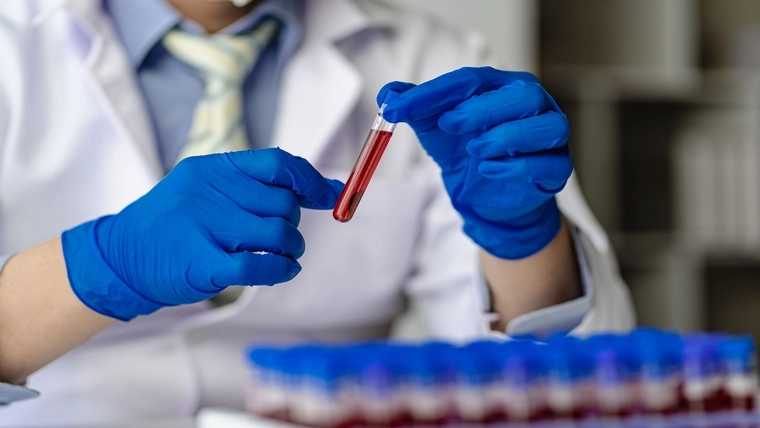
What is Hematology?
Hematology, which means Blood Science, is a sub-branch of internal medicine and deals with the diagnosis and treatment of diseases that occur in blood components and blood-forming organs such as bone marrow. Physicians who specialize in hematology are called Hematologists. Hematologists manage the process by using various unique methods in addition to traditional laboratory tests in the diagnosis and treatment of blood diseases and often in collaboration with other branches of science such as biochemistry, pathology, microbiology, genetics, radiology, radiation oncology and immunology.
Blood is composed of cells, cell particles and proteins in the plasma. The cellular components of blood are erythrocytes, leukocytes and platelets. Erythrocytes (red blood cells) are the most abundant cellular component and carry out the task of carrying oxygen to the tissues in our body. While leukocytes (white blood cells) play a fundamental role in protecting against infections, platelets are cells that work together with clotting factors to control bleeding. The production, differentiation, proliferation and maturation of these blood cells is a process called “Hematopoiesis” and is carried out by the “bone marrow”, which is active in anatomical regions such as the skull bones, ribs, sternum, vertebrae, pelvis, femur and proximal humerus in adults. Other hematopoietic organs other than the bone marrow include the spleen, lymph nodes, thymus and the mononuclear phagocytic system. Therefore, hematology is the branch of science that manages the diagnosis and treatment process of diseases of all these cellular components, plasma proteins and hematopoietic organs.
What are the Diagnostic Methods Used in Hematology?
What Diseases Does Hematology Treat?
Why Should I Choose Florence for Hematology?
Florence Nightingale Hospitals is an organization that provides services at international standards and has all the necessary technical equipment. The Florence hematology team consists of associate professors and professors with strong interpersonal skills and international experience and success in their fields. By providing a patient-centered service, it is aimed to make the disease diagnosis and treatment process as comfortable as possible. Florence Nightingale Hospitals have the necessary test and imaging equipment for the diagnosis of hematological diseases. After the disease diagnosis, the treatment method and process are clarified by the evaluation of the specialist doctor and the patient and their relatives. Doctors help the patient to be prepared by explaining the treatment process and follow-up periods in detail.
- Hematological cancers: Acute and chronic leukemias (blood cancer), Lymphoma (lymph cancers), plasma cell diseases such as multiple myeloma
- Bone marrow diseases: Aplastic anemia, pure red cell aplasia, myelodysplastic syndrome, benign monoclonal gammopathy, myelofibrosis
- Erythrocyte diseases: Anemias, thalassemias, erythrocytosis (such as polycythemia vera), enzyme defects, porphyrias, hemophagocytic syndrome
- Leukocyte diseases: Neutropenia, functional diseases, leukocytosis, lymphohistiocytic diseases
- Platelet diseases: Thrombocytopenias, Platelet dysfunctions, thrombotic microangiopathies, essential thrombocytosis
- Bleeding diseases: Hereditary or acquired coagulopathies, sepsis with DIC, von Willebrand disease; hemophilia patients receiving replacement therapy (pure factors, taxe-donated plasma, etc.); use of hemostatic drugs (ε-aminocaproic acid, desmopressin, recombinant activated factor VII); perioperative hemostasis management, assessment of coagulation and bleeding risks
- Thrombotic diseases: Venous thromboembolism, hypercoagulopathy, use of blood thinners, pre- and post-operative management of thrombotic events
- Polycythemia Vera: Polycythemia vera is a disease characterized by an overproduction of red blood cells in the bone marrow. This can cause the blood to thicken and increase the risk of blood clots.
- Sickle Cell Anemia: Sickle cell anemia is a genetic disease characterized by the sickle-shaped red blood cells due to the abnormal structure of hemoglobin molecules. These cells can cause blockages in blood vessels and reduce the oxygen-carrying capacity.
- Thalassemia: Thalassemia is a genetic disease that prevents the body from producing normal hemoglobin. There are two main types, alpha and beta thalassemia, and it can lead to severe anemia.
Hematology covers the diagnosis, treatment and management of these and many similar diseases. Specific diagnostic methods and treatment protocols are applied for each type of disease.
What are Hematological Examinations?
Hematology exams include a variety of tests used to diagnose and monitor blood disorders. These tests may include:
- Complete Blood Count (CBC): Measures the number and proportions of blood cells.
- Bone Marrow Biopsy: A sample of bone marrow is taken and examined under a microscope.
- Peripheral Blood Smear: Examination of blood cells under a microscope.
- Coagulation Tests: Evaluates the blood's ability to clot.
- Genetic Tests: Used to determine genetic causes of blood disorders.
What Methods Are Used in the Treatment of Hematology Diseases?
The methods used in the treatment of hematological diseases vary depending on the type and stage of the disease and the general health status of the patient. Here are the main methods commonly used in the treatment of hematological diseases:
1. Chemotherapy
Chemotherapy is a drug treatment used to kill cancer cells or stop their growth. It is widely used in the treatment of blood cancers, especially leukemia, lymphoma, and multiple myeloma. Chemotherapy can be administered orally, intravenously, or intramuscularly, depending on the type and stage of the disease.
2. Radiotherapy
Radiotherapy is a treatment method that uses high-energy rays to destroy cancer cells. It is usually used in the treatment of lymphoma and some types of leukemia. Radiotherapy is applied directly to the cancerous area and prevents the growth and spread of cancer cells.
3. Bone Marrow Transplant (Hematopoietic Stem Cell Transplant)
Bone marrow transplantation is a treatment method used in cases where the patient's bone marrow is damaged due to disease.
4. Immunotherapy
Immunotherapy is a treatment that targets cancer cells by boosting the immune system. Immunotherapies, such as monoclonal antibodies, checkpoint inhibitors, and CAR-T cell therapy, are used primarily to treat lymphoma and leukemia.
5. Targeted Therapies
Targeted therapies are drugs designed to target specific molecular targets of cancer cells. These treatments prevent cancer cells from growing and spreading. For example, tyrosine kinase inhibitors, such as imatinib, are used to treat chronic myeloid leukemia (CML).
6. Blood Transfusion
Blood transfusion is a method used to treat low blood cell counts due to anemia or other blood diseases. Blood transfusions can be in the form of red blood cells, white blood cells, platelets, or plasma. This method is used to prevent blood loss and improve the patient's quality of life.
7. Erythropoietin and Other Growth Factors
Erythropoietin and other growth factors are biologic drugs used to increase the bone marrow's production of blood cells. They are especially used to treat anemia, to increase blood cell counts after chemotherapy, and to treat some myelodysplastic syndromes.
8. Surgical Intervention
In some cases, especially if there is an enlarged spleen (splenomegaly) or tumors in the lymph nodes, surgery may be necessary. Surgical procedures such as spleen removal (splenectomy) or lymph node biopsy may be performed for diagnostic and therapeutic purposes.
9. Supportive Treatments
In the treatment of hematology diseases, various supportive treatments are used to improve patients' quality of life and manage side effects during the treatment process. These treatments may include:
- Pain management: Analgesics are used to control pain.
- Infection prevention: Antibiotics and antiviral medications are used for patients with weakened immune systems.
- Nutritional support: Dietitian support is provided to improve the nutritional status of patients.
10. Hormone Therapy
Hormone therapy is used in some hematological diseases. For example, erythropoietin, which is used to treat anemia, is a hormone used to increase the body's production of red blood cells.
Treatment of hematology diseases is planned with a personalized approach depending on the type and stage of the disease and the general health status of the patient. The treatment process is managed with a multidisciplinary approach in order to improve the quality of life of the patients and to ensure that the disease is under control.
When Should You Go to the Hematology Department?
There are various symptoms and conditions that may prompt you to go to the hematology department. If you experience any of the following symptoms, you should consult a hematologist:
- Chronic Fatigue: Constant and extreme tiredness.
- Bruises and Bleeding on the Skin: Bruises that occur for no reason or prolonged bleeding.
- Swollen Lymph Nodes: Obvious swelling in the lymph nodes.
- Frequent Infections: Getting infections frequently as a result of weakening of the immune system.
- Unexplained Weight Loss: Sudden and unexplained weight loss.
What is Done During a Hematology Examination?
During a hematology exam, the doctor evaluates the patient's health history, performs a physical exam, and orders any tests he or she deems necessary. The exam usually includes the following steps:
- Blood Tests: Complete blood count and other specific tests.
- Physical Examination: Examine the lymph nodes, liver, and spleen.
- Biopsy: Bone marrow or lymph node biopsy when deemed necessary.
- Imaging Tests: Imaging techniques such as X-ray, ultrasound, or MRI.

.webp?ext=.webp)

